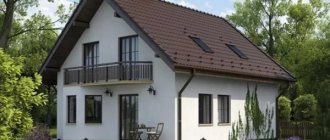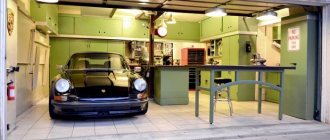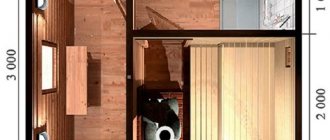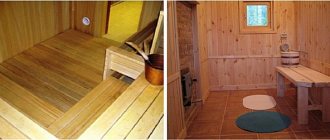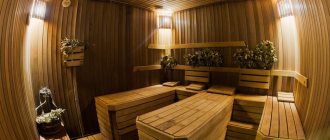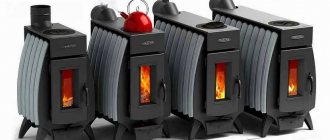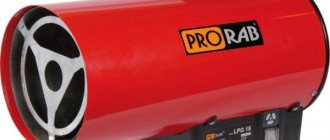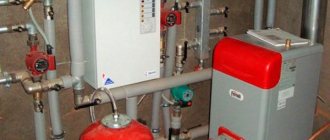In order to maintain a comfortable temperature in the main rooms of the bathhouse and ensure hot water supply, it is important to properly organize heating in the bathhouse from a heater located in the steam room, or use alternative sources. At the same time, each bathhouse owner can create an autonomous heating system independently, without involving outside help.
general information
The tradition of arranging a bathhouse includes a wooden pouring floor.
This option is not always possible. If the base of the bathhouse is made of concrete, then a completely different principle of water drainage is required and, accordingly, a different type of flooring. Tiles are most often used as the most suitable covering for wet rooms. At the same time, the surface of the floor covered with tiles does not have the most comfortable properties - it is cold, which is unacceptable for a bathhouse. In addition, you have to spend more time and resources to heat the floor, which consists of a thick layer of concrete and tiles. The way out was to install a water heated floor, powered by a sauna stove.
From a technology point of view, making a water-heated floor from a sauna stove does not pose any great difficulties. The working body - pipes with coolant - is laid according to the usual pattern, the only exception being the method of pouring the screed, since a slight slope is required for the water to flow into the drainage pipe.
And also there are no questions in organizing the mixing unit (if planned) and other elements of the system that make it possible to regulate and configure the operating mode. Power from a sauna stove is essentially power from a boiler, but with some reservations, which will be discussed in more detail.
Read about heating boilers in the relevant articles: gas, electric.
And the structure of the entire water system is described here.
Gas heating system
When connected to a gas main, heating a bathhouse with gas is the fastest and most efficient option for the system.
The system has two implementation options:
- traditional heater equipped with a gas burner;
- gas boiler with installation of heating radiators and water pipes.
The undoubted advantage of such heating is the absence of unpleasant odors, the formation of soot and soot. At the same time, gas equipment has a compact body, low weight and does not require much space during installation. The power of a standard boiler reaches 45 kW, which is enough to heat a room up to 280 square meters. m.
What problems exist when using antifreeze fluid in heating systems?
Household antifreeze is a special coolant that is used in various systems, including heating ones. As a result, there are several varieties of such mixtures, which are based on aqueous solutions of different substances: alcohols, salts, propylene glycol, ethylene glycol and others. Special additives are necessarily added to such elements to improve the characteristics of the solutions. And an important property is the low freezing point.
Problem #1
Since water and antifreeze have different physical characteristics, when designing a heating system, it is necessary to take into account whether one or another liquid will be used. Basic calculations are made, of course, for water. If you plan to use antifreeze, you will need to change some system parameters:
- boiler power;
- increase the pressure of the circulation pump by 60%;
- increase the volume of the expansion tank by 50%;
- increase the thermal power of radiators by 50%.
Problem #2
Antifreezes based on ethylene glycol have one feature - they “do not like” system overheating. For example, if at any point in the system the temperature exceeds the critical temperature for a given brand of mixture, ethylene glycol and additives will decompose, resulting in the formation of solid precipitates and acids. When precipitation falls on the heating components of the boiler, carbon deposits appear, which reduces heat transfer, stimulates the appearance of new precipitation, and increases the likelihood of overheating.
The acids formed during the decomposition of ethylene glycol react with the metals of the system, as a result of which the development of corrosion processes is possible. Decomposition of additives can cause a decrease in the protective characteristics of the composition in relation to seals, which can cause leakage at the joints. If the system is zinc coated, the use of antifreeze is not permitted.
When overheated, increased foaming occurs, which means that airing of the system is guaranteed. Therefore, in order to eliminate all these phenomena, it is necessary to strictly control the heating process. Since boiler manufacturers do not know the physical properties of the coolants used (except water), they exclude their use.
Problems #3
Antifreezes have increased fluidity. Consequently, an increase in the number of connecting points and elements entails an increase in the likelihood of leaks. Moreover, this problem mainly appears when the system has cooled down, when the heating is turned off. When cooled, the volume of metal compounds decreases, microchannels appear, through which the composition oozes.
Application
The use of a water heated floor from a sauna stove is possible provided there is a concrete base that allows you to fill the screed when installing the circuits.
The bathhouse belongs to the category of wet rooms, which require the use of materials and structures that are not afraid of contact with water or steam.
Therefore, the most practical option is with a concrete screed and tiles as a floor covering, which we are considering.
Additionally, using underfloor heating in a break room where the temperature usually doesn't rise too high will help equalize the heating levels between the floor and walls. Concrete floors are difficult to heat up and absorb a large amount of thermal energy, causing the temperature regime of the room to become less stable and the heating is not maintained for a long time. The use of heated floors significantly improves the situation, since in addition to heating the floor, it is provided with high-quality insulation.
Main types of furnaces
Heater stoves, which are used to heat baths in winter, can be divided according to the type of operation into two categories: continuous and periodic.
A continuous furnace is characterized by a small wall thickness and a small volume of stones. This type of stove has the ability to regulate the temperature both independently and automatically. In this case, the maximum temperature reaches 350 degrees . To heat a stove of this type, it is enough to connect it to electricity. Gas is also suitable as a fuel.
Batch oven
If you decide to use electric heating for the bath, you can adjust the current strength in the heating elements yourself. Do not forget that when installing the stove you are required to install an automatic safety system. If the temperature of the walls exceeds the permissible values, the heating of the bathhouse with electricity will automatically stop supplying electricity.
Tip: Constant heater stoves can also be heated with coal or wood. Whatever you use to heat your stoves, be it water heating in a bathhouse, remember that it is important to separate the combustion chamber and smoke channels from the backfill.
To do this, you can use a steel sheet or lay cast iron tiles. This way, you will prevent combustion products from entering the bathhouse. It is also an excellent protection for stones from soot deposits. The latter, when in excess, pollutes the air in the bathhouse.
Long-lasting oven
Periodic heater stoves are represented by thick masonry and a large volume of bricks. Thick walls will protect the surfaces of the stove from overheating, and the stove will give off heat for a long time.
This heating in the bath allows you to heat the lower part of the stove to 1100 degrees . Operating at such a high temperature, there is no soot settling as it burns. To save fuel, they use the principle of “black” combustion. In this case, smoke gases pass through the sauna. This heating option is very dangerous. The surface of the stove and walls is covered with soot. As for the “white” version of the firebox, the firebox compartment is covered with a damper. It is allowed to open it after complete combustion of the fuel.
The most ideal fuel for heating a bathhouse can be firewood. It is not advisable to resort to using coal for heating. It is quite difficult to sharply reduce the temperature, which leads to destruction of the internal surfaces in the furnace. And this already violates safety regulations.
Tip: To achieve economical use of fuel, it is important that it burns completely.
For more information about a fireplace stove with a water boiler, watch the video:
Ethylene glycol based antifreezes
To obtain the required crystallization temperature, the composition is diluted with water, preferably, of course, distilled. The most common brands in Russia are Hot Blood, Dixis, Nort. By adding a certain amount of water, the freezing point can be in the range from -10°C to -65°C. And you need to understand that even when the crystallization temperature approaches, there is still a considerable temperature range at which both liquid and ice are preserved. This condition is called sludge. Under such conditions, system rupture is excluded.
Choice
What are the characteristics of gas stoves intended for baths?
Stones
The traditional stove for a Russian bath - a heater - is distinguished by a large number of round stones placed in a tray. The tray is located above the firebox and, after lighting the stove, heats up quite quickly; the stones heat up to temperatures of 200 degrees or more.
They perform a dual function:
- By accumulating heat, the stones maintain a high temperature in the steam room after the wood burns out.
- The very name “steam room” implies the presence of steam. The traditional mode for a Russian bath is 60 degrees with very high humidity. To add steam, just splash water from a ladle onto the stones.
Gas heater Ermak.
If you are a fan of the Russian bathhouse, a heater is your obvious choice. If you want to use a sauna with high temperatures and minimal humidity, you don't need stones. Heat accumulation in the case of gas, you understand, is of no value.
Water tank location
It may be located in the stove body or around the chimney. In the first case, the heat source for heating water is the burner flame, in the second - combustion products. In the author’s humble opinion, the second option is preferable: the tank additionally cools the combustion products, increasing the efficiency of the device.
Gas stoves
If you use bottled gas, a stove that combines two types of fuel would be an excellent solution for you. When the cylinder runs out, you can light the stove with wood.
Burner
Often it is purchased separately.
What should you pay attention to when purchasing?
- With a steam room volume of 18 m3, the reasonable maximum gas consumption by the burner is 1.5 m3 per hour. It is easy to recalculate the required productivity for your volume.
- The registration certificate and markings must be present. Automatic shutdown when the flame goes out is mandatory (in fact, now it is available almost everywhere).
- Any damage, even seemingly uncritical, puts an end to the device. Big and fat. We are talking about people's lives and health.
Domestic burner Teplofor.
Advantages and disadvantages
A heated water floor in a bathhouse from a stove is a complex design that has its own advantages and disadvantages.
Advantages of water heated floors:
- equalizing the temperature regime of the room, increasing the comfort and coziness of visiting the bathhouse;
- the room is heated through two channels - directly from the stove and across the entire surface of the floor, which increases the intensity of heat exchange and reduces the time for preparing the bath;
- heating of the room is uniform, without cold spots or zones;
- the screed has high thermal inertia, accumulating heat in its thickness and releasing it into the interior of the bathhouse for quite a long time;
- it is possible to use a sauna stove as a source of coolant, without the use of additional devices for water preparation.
Minuses:
- complexity of installation work, the need to use expensive equipment;
- complexity of repair work;
- laying a water-heated floor pie increases the surface level, lowering the height of the ceilings;
- the need to re-equip the furnace;
- the need to organize high-quality drainage of water from the system to prevent freezing of residual water and destruction of pipelines or mechanisms.
All the advantages and disadvantages are basically common to water heated floors.
Warm dressing room
Most options for heating the dressing room can be used in the process of planning a bath. A preliminary analysis of the possibilities will help you choose wisely a sauna stove that will perform the functions of a heater and a device responsible for heat in the remaining sauna rooms. At the finishing stage, you can create an additional heating system.
If the owners are faced with the problem of a cold dressing room after the fact, and the room already needs heating, it should be modernized with a minimal investment of time, effort and money. Regardless of what stage of construction the bathhouse is at, you can organize heating of the dressing room with your own hands or with the help of specialists.
Scheme for insulating the walls of the dressing room
To understand how to do this correctly and which heating system to choose, you should consider the main components of a warm dressing room and analyze the heating devices that allow you to heat the room.
Principle of operation
The piping system, embedded in a concrete screed, receives power from a stone furnace, converted to allow parallel heating of the coolant. When the stove is ignited, heating of the floor heating system begins, which by the time the bath is ready is in full working order. The circulation of the coolant is carried out using a circulation pump included in the mixing unit. Warm pipes heat the concrete screed and floor surface, which radiates energy into the room.
Device
The water heated floor system consists of several components:
- Warm floor contours. These are pipelines, evenly laid at a short distance from each other on the floor and filled with concrete screed. To reduce the load on the circulation pump, these pipes are divided into several sections of equal length, called contours or loops. They are the main working body of a water heated floor, releasing thermal energy into the screed and onto the floor surface.
- Mixing unit. An important element of the heated floor system, providing regulation, configuration and automatic maintenance of the operating temperature of the heated floor. Since a sauna stove does not have the ability to produce water at the required temperature, the coolant can be very hot, almost boiling. It is impossible to direct such a flow into the circuits, so a mixing unit is used to make a mixture of the cooled return flow with the hot forward flow. Without such a knot, it will become impossible to walk on the floor.
- Heat exchanger. A device in which the coolant is heated from the furnace. In practice, this is a container or register made of pipes filled with coolant. It is located in the upper part of the stove, above the firebox. If the stove is equipped with a water tank, then the firebox is connected with pipes containing coolant.
Important! High-quality operation of the system is based on the reliability of installation and connection of the circuit pipes. Elements that are visible can be easily repaired, but pipes hidden in concrete are very difficult to repair and require serious work.
The need for separate heating of water for washing and coolant is that when using ordinary water in a heated floor system, it is necessary to be able to drain it completely, which is very difficult to achieve. Small amounts of water left in the pipes may freeze and cause them to burst. Therefore, you will either have to constantly heat the bath, which is uneconomical, or use antifreeze, which cannot be mixed with water; a separate heating line will be required.
Features of the functioning of the stove-heater
In summer cottages they build family-type bathhouses for themselves, in which one stove-heater is enough. This type of heating in the bathhouse will take on all the main functions. This is precisely why it is important to observe all the details when building a furnace. It is better to make a small stove-stove. This will save space. At the same time, its heating time will be minimal, and it will give off heat for as long as possible. But the most important thing is what kind of fuel it will be heated with. It's best if the fuel is cheap. Popular - water heating baths.
High heat capacity will allow you to get good steam for a long time. In addition, dry heat will be used to heat the room and water for washing. To ensure that everything suits you, when heating a bathhouse with your own hands, take into account the ratio of the size of the stove, the room and the purpose of the bathhouse. Make sure that your stay in the bathhouse is as safe as possible for you and your family.
Advice: Think through to the smallest detail what materials you will use when building a bathhouse and stove so that they are not flammable. Take a responsible approach to the issue of ventilation. Whether it is gas heating in a bathhouse or electric, this will allow you not to get burned from combustion products.
What problems exist when using antifreeze fluid in heating systems?
(Slovakia) declares that it is not responsible for the consequences caused by the use of antifreeze. Cast iron boilers manufactured by the company are not designed to interact with non-freezing liquids. Vaillant (Germany) is even more categorical, declaring that non-freezing liquids cannot be used in wall-mounted boilers!
As for other manufacturers, everything is more confusing here. Some of them inform about the use of special paronite gaskets in the design of boilers, which are suitable for many types of antifreeze. However, the other side of the coin is not advertised: difficulties with seals are not the only problem when using antifreeze.
Problems #3
Why do you need additional heating?
Of course, with a very tight budget, you can refuse additional heating, using only the classic option - a good cast-iron or brick stove
. This will be quite enough to take a bath, and then dive into luxurious snowdrifts with a running start, while experiencing the whole unique range of feelings. But if you can afford to spend extra money, then your bathhouse will become even more cozy and comfortable.
A heater stove is the most popular way to heat a sauna.
Additional heating is usually understood as additional heating equipment that allows you to maintain a high temperature not only in the steam room, but also in the dressing room. After all, many bathhouse connoisseurs love to sit with a group of friends in the dressing room after visiting the bathhouse itself to talk about life, remember past times and discuss plans for the future.
Unfortunately, when using conventional stoves, it is not possible to heat the dressing room. And if this is not a problem in summer, then in winter it can cause discomfort. Almost all the heat is given to the steam room, as a result of which being in the waiting room for even a few minutes to undress or dress can be unpleasant due to the extremely low temperature. What can we say about gatherings and long conversations!
But when installing additional heating, you can always maintain a suitable temperature for you in the dressing room, which is located on the same level as the steam room or in the attic.
Installation
Stages of installing a water heated floor:
- Preparing the base, removing dirt, inspecting the surface.
- If there are flaws - cracks, depressions, etc. - a thin leveling screed is poured.
- Double layer of waterproofing. The surface of the concrete is covered with a layer of hot bitumen, on which roofing felt is laid. The strips are overlapped by at least 10 cm. After this, bitumen and roofing felt are applied again.
- Laying thermal insulation. Hard and moisture-proof insulation is used - EPPS, penoplex, etc. The insulation layer must be at least 5 cm, laying is done as tightly as possible, without gaps.
- A mounting mesh is placed on the surface of the insulation to secure the pipelines.
- A damper tape is installed along the perimeter of the walls to compensate for the thermal expansion of the screed.
- Laying a system of pipes (circuits) in a certain order. Fixation with clamps on the mounting grid.
- Connecting pipes to collectors, test run of the system, checking functionality, pressure testing.
- Laying drainage pipes to remove used water (where necessary), connecting drain funnels.
- Filling the screed. During this action, the underfloor heating pipes must be under pressure.
- After the screed has hardened, the tiles are laid. In this case, a slight slope towards the drain holes should be provided to organize the drainage of used water.
Homemade boiler for a bath
You can build a boiler for heating a bathhouse with your own hands. You need a pipe of a certain diameter, a welding machine and a grinder.
You can do . For this, it is very convenient to use sections of thick-walled pipe. The best option is a piece with a diameter of 51 cm and a length of 100 cm. Such a boiler, even in a very cold winter, can heat not only the steam room itself, but also other rooms.
Prepare the following tools for work:
- electric welding machine;
- “grinder” with metal circles;
- pipe of suitable length and diameter.
The selected section of thick-walled pipe will serve as the body of the future boiler. Inside the housing, 3 supports should be welded parallel to the ground at 3 different levels. These supports are made from ordinary reinforcement bars 30 cm long and 14 mm in diameter.
The lower support will make it possible to install the bottom of the heating unit. The height of the second support is selected in accordance with the size of the blower door installed in the boiler. The third support will be installed at a distance of about 20 cm from the top of the unit base.
To construct the bottom of the boiler, a solid metal circle with a thickness of at least 4 mm is used. Grate bars can be made from a metal circle with slots. Choose a circle as thick as possible, then the lid can also be used as a support for stones. The lid is made of a metal circle with a thickness of at least 5 mm. A hole should be made in the cover, which will be used to attach the adapter ring of the chimney pipe.
The system for placing supports under the partitions implies their location one above the other. Stove and blower doors are installed in the hole for the box, which must be cut in the side of the pipe from the very bottom.
The depth of the box should be selected in accordance with the thickness of the wall that will be used to make the boiler firebox. A partition installed inside the box is necessary to separate the combustion and ash compartments. The level of this partition must coincide with the grate partition installed in the inside of the boiler.
The installation procedure is as follows. First, the box is welded, after which the bottom, grate and top cover are inserted into the boiler body
When performing work indoors, you need to pay attention to the fact that the box passing through the wall goes into the furnace room or outside, and not into the dressing room
At the next stage, a chimney is installed and stones are placed on the top cover of the boiler. The boiler is directly installed on a special foundation. you can organize such heating with your own hands.
Results: water or antifreeze?
First you need to determine how high the probability of a long (more than 24 hours) power outage in a country house is. If such phenomena are unlikely, then you definitely need to fill the heating system with water, supplementing it with a battery uninterruptible power supply. If power outages are not just likely, but occur regularly, it is recommended to use antifreeze.
If this happens, then you should use distilled liquid. As already noted, the use of antifreeze in galvanized systems is prohibited. Also, the composition should not be diluted by more than 50 percent, which reduces the anti-corrosion characteristics of the mixture. You also need to remember about the aging of antifreeze, so it will have to be changed after some time.
Typically the period is about five years. Therefore we can draw a conclusion. It is impossible to unequivocally answer the question of whether it is worth pouring antifreeze into the heating system of a house; it is the best coolant. You will have to compare your conditions with those described above, based on which you will make a decision. Finally, we can only note that since the active use of antifreeze in heating, not a single serious accident has been reported. Therefore, statistics suggest that in practice everything may not be so scary.
Several alternative options
Despite the fact that the options described above are the most popular and considered optimal, I decided to briefly mention some alternatives. In fact, they are varieties of stove heating, but have their own characteristics.
For example, if you have such capabilities, then you can install a diesel fuel boiler in your bathhouse. But this option requires a separate room (diesel fuel does not smell much), and you need to think about fuel storage.
There are also pyrolysis heating boilers. The undoubted advantage of such a boiler can be considered a very long, almost complete combustion of fuel. The disadvantage is the high cost and difficulty of operation (for example, raw wood does not burn in it).
It is also possible to use long-term combustion boilers, capable of burning a separate batch of fuel for up to 5 days, maintaining the desired temperature. There are even options for high-quality graded coal. But this is rather an “industrial” option, which is not suitable for a good traditional bath.
This is where I will finish the review of methods for heating a bath. Which heating is better is up to you to decide, focusing on your needs and capabilities. The main thing is that the rooms are warm and comfortable. Thank you for reading to the end. Until next time, see you on the pages of other articles. Bye!
Wisdom Quote: There are no dark times, only dark people (Roland Romain).
